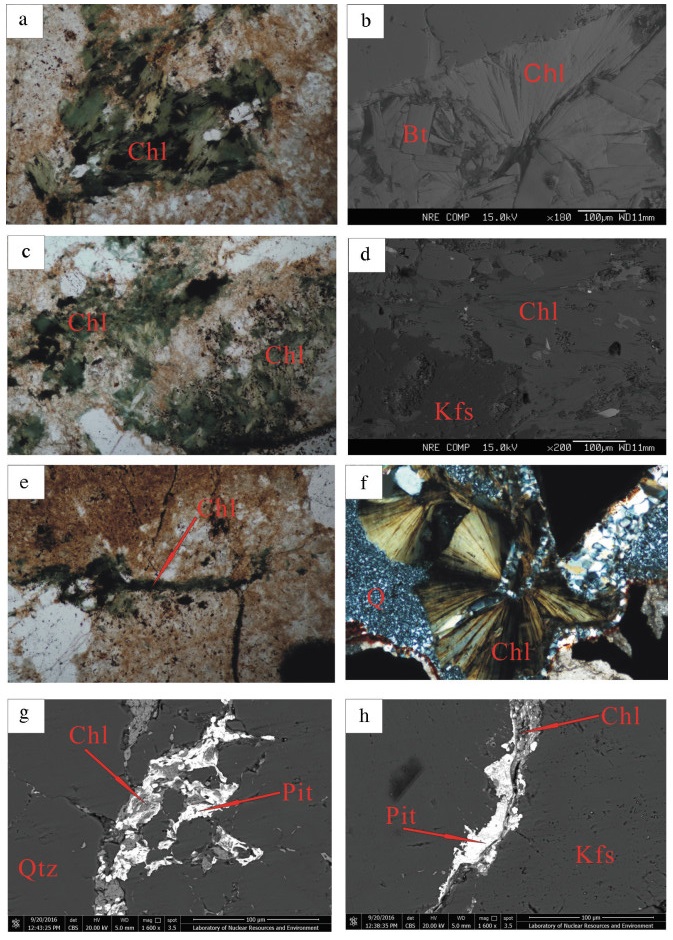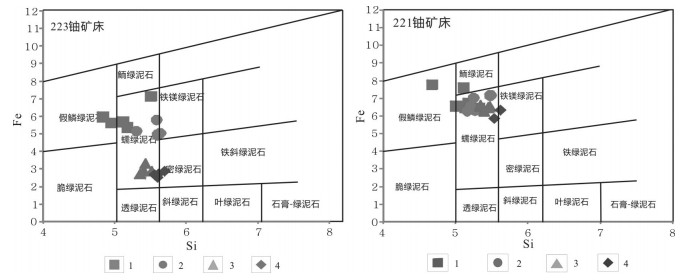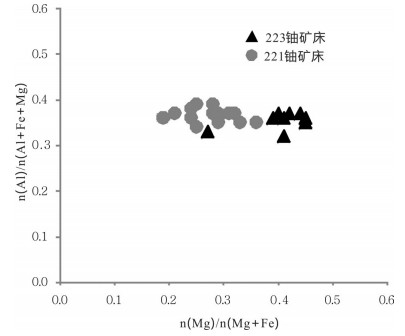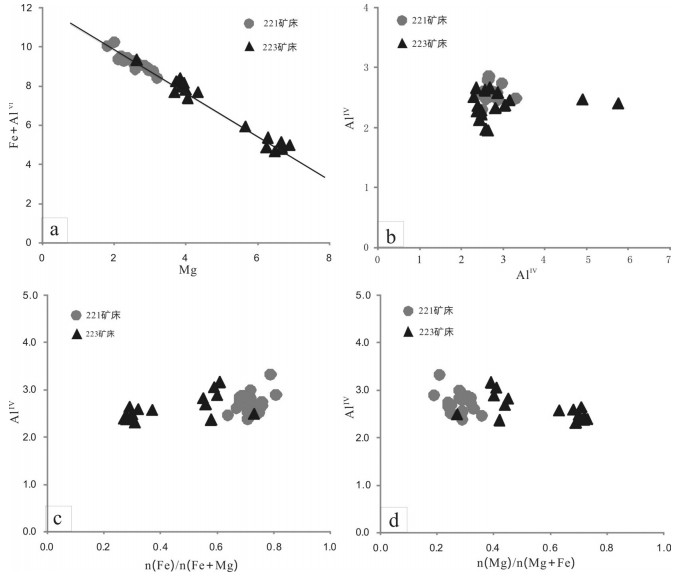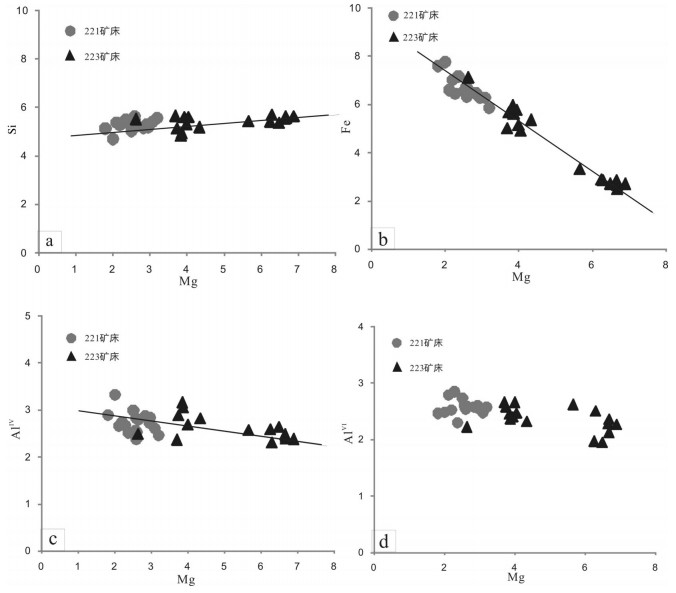Genesis of chlorite in the Huangsha uranium deposit, middle part of Nanling Mountains and its relationship with uranium mineralization
-
摘要:
绿泥石化是南岭中段黄沙铀矿区中广泛发育的热液蚀变类型。在岩相学的基础上,通过电子探针分析技术研究了铀矿区内221、223铀矿床绿泥石的矿物共生组合类型与形貌特征,划分了绿泥石的化学类型,提出该矿区绿泥石的4种产出状态,探讨了绿泥石的形成温度和环境,讨论了绿泥石的形成机制及其与铀成矿的关系。研究结果显示该矿区绿泥石:(1)在形貌特征上,矿前期绿泥石主要呈黑云母假象或星点状、团块状产出,成矿期绿泥石主要呈脉状产出;(2)在成因类型上,绿泥石主要有黑云母蚀变型、长石蚀变型、裂隙充填型和与铀矿共生型4种类型;(3)绿泥石的形成温度为200~310℃,其中与铀矿物共生型绿泥石的平均形成温度为215℃,属于中低温热液矿床范围;(4)绿泥石主要形成于还原环境,形成机制主要有溶解-沉淀和溶解-迁移-沉淀两种。
Abstract:Chloritization is a type of hydrothermal alteration widely developed in the Huangsha uranium deposit in the middle part of the Nanling Mountains. Based on petrographic studies, the authors investigated the types and morphological characteristics of chlorite minerals in No. 221 and No. 223 uranium deposits by using electron microprobe analysis, and classified chemical types of chlorite. Four kinds of chlorite production status were recognized, and the temperature and environment of the formation of chlorite as well as the relationship between chlorite formation and uranium mineralization was discussed. The results are as follows:(1) The early chlorite was mainly of biotite pseudomorph or starlike shape characterized by mass output, and the metallogenic chlorite was mainly produced in the vein. (2) There are four types of genesis i.e., chlorite biotite alteration, feldspar alteration, fracture filling type and uranium deposit association. (3) The chlorite-forming temperature was 200-310℃, and the average formation temperature of chlorite coexisting with uranium minerals was 215℃, suggesting a middle-low temperature hydrothermal deposit. (4) Chlorite was mainly formed in a reductive environment, and the formation mechanism was dissolution-precipitation and dissolutionmigration-precipitation.
-
-
图 1 黄沙铀矿区地质简图(底图据杜乐天,1982)
1—第四系;2—细粒二云母花岗岩;3—中细粒二云母花岗岩;4—粗中粒二云母花岗岩;5—中基性岩脉;6—硅化、蚀变构造带;7—碱交代岩;8—矿带及编号;9—地质界线
Figure 1. Geological map of the Huangsha uranium ore district (after Du, 1982)
1-Quaternary; 2-Fine-grained two mica granite; 3-Medium-fine grained two mica granite; 4-Coarse-grained two mica granite; 5-Intermediatebasic dikes; 6-Silcified, tectonic alteration zone; 7-Alkaline metasomatic rock; 8-Ore belt and its serial number; 9-Geological boundary
图 2 黄沙铀矿区绿泥石镜下特征
a、b—黑云母蚀变型绿泥石,保留黑云母假象;c、d—长石蚀变型绿泥石,呈星点状、蠕虫状分布于长石中;e、f—裂隙充填型绿泥石,充填于长石、石英裂隙中,或叠加于石英脉之上;g、h—与铀矿物密切共生型绿泥石;Chl—绿泥石;Qtz(Q)—石英;Kfs—钾长石;Pit—沥青铀矿
Figure 2. Microscopic features of chlorites in the Huangsha uranium ore district
a, b-Chlorite subjected to biotite alteration; c, d-Chlorite subjected to feldspar alteration showing a star-like, worm-like distribution in feldspar; e, f-Chlorite of fissure fillin type, chlorites filled in feldspar, quartz fissure, or superimposed on the quartz veins; g, h-Chlorite associated closely with uranium minerals; Chl-Chlorite; Qtz(Q) -Quartz; Kfs-K-feldspar; Pit-Pitchblende
图 3 黄沙铀矿区221、223铀矿床绿泥石分类图解(底图据Deer et al., 1962)
1—黑云母蚀变型绿泥石;2—长石蚀变型绿泥石;3—裂隙充填型绿泥石;4—与铀矿物共生型绿泥石
Figure 3. Classification of chlorites from No.221, No. 223 uranium deposit in the Huangsha uranium ore district (after Deer et al., 1962)
1-Chlorite subjected to biotite alteration; 2-Chlorite subjected to feldspar alteration; 3-Chlorite of fissure filling type; 4-Chlorite associated closely with uranium minerals
图 4 黄沙铀矿区221、223铀矿床绿泥石原岩判别图解(据Laird, 1998)
Figure 4. Source rock discrimination diagram of chlorite from the No.221, No. 223 uranium deposit in the Huangsha uranium ore district(after Laird, 1998)
表 1 黄沙铀矿区221、223铀矿床中绿泥石的电子探针化学成分(%)
Table 1 EPMA analyses of chlorite from No. 221, No. 223 uranium deposit in the Huangsha uranium ore district (%)

表 2 黄沙铀矿区221、223铀矿床绿泥石的电子探针特征值
Table 2 Characteristic values of electron microprobe analysis of chlorite from No. 221, No. 223 uranium deposit in the Huangsha uranium ore district

-
Ai Yongfu, Liu Guoping. 1998. The study chlorite at Dajing deposit in Inner-Mogolia of China[J]. Acta Scientiarum Naturalium Universititas Pekinensis(Natural Sinence Edition), 34(1):97-105(in Chinese with English abstract). http://en.cnki.com.cn/Article_en/CJFDTOTAL-BJDZ801.014.htm
Battaglia.1999. Applying X-ray diffraction geothermometer to chlorite[J].Clays and Clay Minerals, 47(1):54-63. http://cn.bing.com/academic/profile?id=e22165586e651498f5a050e6deca4dd3&encoded=0&v=paper_preview&mkt=zh-cn
Bevins R E, Robinson D, Rowbotham G. 1991. Compositional variations in mafic phyllosilicates from regional low-grade metabasites and application of the chlorite geothermometer[J]. Journal Metamorphic Geology, 9:711-721. http://cn.bing.com/academic/profile?id=1985182539f8ec9eab2c8c45fc0cf174&encoded=0&v=paper_preview&mkt=zh-cn
Bryndzia L T, Steven D S. 1987. The composition of chlorite as a function of sulfur and oxygen fugacity:An experimental study[J]. American Journal of Science, 287:50-76. doi: 10.2475-ajs.287.1.50/
Cathelineau M.1988. Catio site occupancy in chlorites and illite as a function of temperature[J]. Clay Minerals, 23:471-485. doi: 10.1180/claymin.1988.023.4.13
Cathelineau M, Nieva D. 1985. A chlorite solid solution geothermometer:The LosAzufres(Mexico) geothermal system[J]. Contribution to Mineralogy and Petrology, 91:235-244. doi: 10.1007/BF00413350
Chen Qiping. 2010. Discussion on the relationship between uranium mineralization belt sodium metasomatism and uranium mineralization in the north margin of North Qilian, Gansu[J]. Gansu Science and Technology, 26(17):33-36(in Chinese with English abstract).
Cheng Huahan, Ma Hanfeng, Xiang Weidong. 2000. Study on changes of existing state of uranium during alkalic metasomatism using Fission-Track method[J]. Uranium Geology, 16(5):291-296(in Chinese with English abstract). http://www.wanfangdata.com.cn/details/detail.do?_type=perio&id=ykdz200005006
Decaritat P, Hutchion I, Walshe J L. 1993. Chlorite geothememetry:A review[J]. Clays and Clay Minerals, 40:470-479. http://d.old.wanfangdata.com.cn/NSTLQK/NSTL_QKJJ0234822381/
Deer W A, Howie R A, Iussman J. 1962. Rock-Forming Minerals:Sheet Silicates[M]. London:Longman, 270.
Du L T. 1982. Granite Type Uranium Deposit Collection[M]. Beijing:Atomic Energy Press.
Fang Qinghao, Feng Junchu, He Lingyi. 1987. The s-type granite suite in Darongahan Guangxi provinde[J]. Acta Petrologica Sinica, (3):23-34, 100 (in Chinese with English abstract).
Foster M D. 1962. Interpretation of the composition and classification for the chlorite[J]. US Geology Survey Prof Paper, 414A:33. http://www.researchgate.net/publication/291826835_Interpretation_of_the_composition_and_a_classification_of_the_chlorites
Fu Jianming, Ma Changqian, Xie Caifu, Zhang Yeming, Peng Sunbo. 2004. Zircon SHRIMP dating of the Cailing granite on the eastern margin of the Qitianling granite, Hunan South China, and its significance[J].Geology in China, 31(1):96-100(in Chinese with English abstract). http://www.wanfangdata.com.cn/details/detail.do?_type=perio&id=zgdizhi200401014
Guo Guolin, Liu Chengdong, Pan Jiayong, Zhang Zhanshi, Li Xingbin. 2012. Character of chlorite and its relationship to uranium mineralization in uranium deposit No.302[J]. Uranium Geology, 28(1):35-41(in Chinese with English abstract). http://www.wanfangdata.com.cn/details/detail.do?_type=perio&id=ykdz201201005
Hiller S, Velde B.1991.Octahedral occupancy and the chemical composition of diagenetic (low-temperature) chlorite[J]. Clay Minerals, 26:149-168.
Hu Shouxi, Zhou Shunxi, Ren Qijiang, Sun Mingzhi. 1982. Theoretical basis of alkali metasomatic metallogenic model and its metallogenic mechanism[J]. Geology and Exploration, (1):1-6(in Chinese with English abstract).
Hua Rengming, Li Xiaofeng, Zhang Kaiping, Ji Junfeng, Zhang Wenlan. 2003. Characteristics of clay Minerals derived from hydrothermal alteration in Jinshan gold deposit:Implication for the environment of water-rock interaction[J]. Acta Mineralogica Sinica.23(1):23-30(in Chinese with English abstract). http://www.cnki.com.cn/Article/CJFDTotal-KWXB200301004.htm
Huang Guolong, Wu Lieqing, Deng Ping, Zhu Ba, Zhang Yanchun. 2006. Analysis of geological setting of uranium mineralization in Jiuquling area, Hunan[J].Uranium Geology, 22(5):267-275 + 280(in Chinese with English abstract). http://www.wanfangdata.com.cn/details/detail.do?_type=perio&id=ykdz200605003
Inoue A. 1995. Formation of clay minerals in hydrothermal environments[C]//Veide Origin and Mineralogy of Clays. Berlin: Springer, 268-30.
Laird J.1998. Chlorites: Metamorphic petrology[C]//Bailey S W.Hydrous Phyllosilicattes. Reviews in Mineralogy, 9: 405-453.
Li Jinyi.2009. Cycles and Stages of Geological History of China Mainland[J]. Geology in China, 36(3):504-527(in Chinese with English abstract). http://www.wanfangdata.com.cn/details/detail.do?_type=perio&id=zgdizhi200903003
Li Renze, Liu Chengdong, Liangliang, Kong Ming, Wan Bing, Wan Jianjun. 2016. Characteristics and geological significance of chlorite from the Dafushang eranium deposit in Taoshan area, Jiangxi Province[J]. Acta Petrologica et Mineralogica, 27(2):297-305(in Chinese with English abstract). http://en.cnki.com.cn/Article_en/CJFDTotal-YSKW201602010.htm
Li Xiaofeng, Hua Renming, Ji Junfeng, Lu Jianjun, Liu Shengxiangxian, Liu Lianwen. 2002. Origin of illite and its relation with ore-forming fluids in yinshan polymetallic deposit, Dexing, Jiangxi Province[J]. Chinese Journal of Geology, 37(1):86-95(in Chinese with English abstract). http://www.wanfangdata.com.cn/details/detail.do?_type=perio&id=dzkx200201010
Liu Yingjun, Cao Liming. 1987. Introduction to Elemental Geochemistry[M]. Beijing:Geological Publishing House, 124-128(in Chinese with English abstract).
MacDowell S D, Elders W A. 1980. Authigenic layer silicate minerals in borehole Elmore ISalton Sea geothermal field, California, USA[J]. Contribution to Mineralogy and Petrology, 74:293-310. doi: 10.1007/BF00371699
Martinez-Serrano R G, Dubois M.1998. Chemical variations in chlorite at the Los Humeros geothermal system, Mexico[J]. Clays and Clay Minerals, 46(6):615-628. http://cn.bing.com/academic/profile?id=eb5b9f5babd54129701df29b67294f13&encoded=0&v=paper_preview&mkt=zh-cn
Niteo F. 1997. Chemical composition of matapelitic chlorites:X-ray diffraction and optical property approach[J]. Eur.J.Mineral, 829-841.
Raused-Colom J A, Wiewiora A, Matesanz E.1991.Relation between composition and d001 for chlorite[J].Am. Mineral., 76:1373-1379.
Shang Pengqiang, Hu Ruizhong, Bi Xianwu, Zhang Guoquan, Tian Jianji. 2012. Sr, Nd and Pb isopotic geochemistry of gangue minerals in the Xiazhuang uranium orefield, northern Guangdong Province[J]. Geology in China, 39(6):1847-1856(in Chinese with English abstract). http://www.cqvip.com/QK/90050X/20126/44621350.html
Walshe J L.1986. A six-component chlorite solid solution model and the conditions of chlorite formation in hydrothermal and geothermal systems[J]. Econ. Geol., 81:681-703. http://cn.bing.com/academic/profile?id=ab0540f63585e27f2a908363c456010f&encoded=0&v=paper_preview&mkt=zh-cn
Wang Xiaoyu, Mao Jingwen, Chen Yanbo, Zhang Xinkang, Liu Peng, Liu Shihua, Fang Si. 2014. Characteristics of chlorite from the Xinliaodong Cu polymetallic deposit in eastern Guangdong province and their geological significance[J]. Acta Petrologica et Mineralogica, 33(5):885-905(in Chinese with English abstract) http://www.wanfangdata.com.cn/details/detail.do?_type=perio&id=yskwxzz201405007
Wei Jinting, Chen Qiping, An Guobao. 2009. Discussion about the relationship between sodium metasomatism and uranium mineraliza tion in uranium metallogenic belt on north edge of middle section of Northern Qilianshan[J]. Mineral Resources and Geology, 23(1):36-41(in Chinese with English abstract).
Wei Zhengyu, Zhang Shuming, Liu Jinzhi, Chen Yunjie, Fu Chengming, Zhang Liang. 2014. Characteristics and significance of chlorite in the Longshoushan alkalimetasomatic type uranium depost[J]. Acta Petrologica et Mineralogica, 33(3):517-526(in Chinese with English abstract). http://en.cnki.com.cn/Article_en/CJFDTOTAL-YSKW201403010.htm
Xie X G, Gary R. Byerly Ray E. Ferrell Jr. 1997. Ⅱ b trioctahedral chlorite from the Barberton greenstone belt:Crystal structure and rock composition constraints with implications to geothermometry[J]. Contrib. Mineral. Petrol., 126:275-291.
Zang W, Fyfe W S. 1995. Chloritization of the hydrothermally altered bedrock at the Igarape Bahia gold deposite, Carajas, Brazi[J]. Mineral Deposita, 30:30-38(in Chinese with English abstract). doi: 10.1007/BF00208874
Zhang Bangtong. 1994. Geochemical evidence for uranium mobilization and migration in granites form South China[J]. Geochimica, 23(2):161-167(in Chinese with English abstract).
Zhang Chengjiang.1996.The genesis of uranium and non-uranium bearing granites from several complexes in South China and their relationship to uranium mineralization[J].Journal of Chengdu Institute of Technology, 23(4):33-40(in Chinese with English abstract).
Zhang Wanliang, Gao Mengqi, Lü Chuan, Huang Chao, Huang Di, Xie Zhicong.2018. Zircon LA-ICP-MS U-Pb dating and its geological significance in Lujing area of Hunan and Jiangxi border[J]. Geological Survey and Research, 41(3):161-166, 175. http://d.old.wanfangdata.com.cn/Periodical/qhwjyjjz201803001
Zhao Xiling, Liu Kai, Mao Jianren, Ye Haimin.2012. Metallogenesis of two types of late early Yanshanian granitoids in South China:Case studies of south Jiangxi and southwest Fujian[J]. Geology in China, 39(4):871-886(in Chinese with English abstract). http://cn.bing.com/academic/profile?id=08c8bb3eb9edfb7366b839e0af01a711&encoded=0&v=paper_preview&mkt=zh-cn
Zhang Yuyan, Li Yuying, Cao Shousun. 2011. Alteration zone and its geochemical characteristics of Julongan uranium deposit[J]. Uranium Geology, 27(2):95-102(in Chinese with English abstract). http://www.wanfangdata.com.cn/details/detail.do?_type=perio&id=ykdz201102006
Zhang Zhanshi, Hua Renming, Ji Junfeng, Zhang Yanchun, Guo Guolin, Yin Zhenping. 2007. Characteristics and formation conditions of chlorite in No.201 and No.306 uranium deposit[J]. Acta Mineralogica Sinica, 27(2):161-172(in Chinese with English abstract). http://www.cnki.com.cn/Article/CJFDTotal-KWXB200702010.htm
艾永福, 刘国平.1998.内蒙古大井矿床的绿泥石研究[J].北京大学学报(自然科学版), 34(1):97-105 http://www.cnki.com.cn/Article/CJFDTotal-BJDZ801.014.htm 陈其平.2010.甘肃北祁连中段北缘铀成矿带钠交代与铀成矿关系探讨[J].甘肃科技, 26(17):33-36. http://d.old.wanfangdata.com.cn/Periodical/gskj201017012 程华汉, 马汉峰, 向伟东. 2000.利用裂变径迹方法研究碱交代作用中铀赋存状态的变化[J].铀矿地质, 16(5):291-296. http://www.wanfangdata.com.cn/details/detail.do?_type=perio&id=ykdz200005006 杜乐天.1982.花岗岩型铀矿床文集[M].北京:原子能出版社. 方清浩, 冯君储, 何令仪.1987.广西大容山S-型花岗岩套[J].岩石学报, (3):23-34, 100. 付建明, 马昌前, 谢才富, 张业明, 彭松柏. 2004.湖南骑田岭岩体东缘菜岭岩体的锆石SHRIMP定年及其意义[J].中国地质, 31(1):96-100. http://geochina.cgs.gov.cn/geochina/ch/reader/view_abstract.aspx?file_no=20040115&flag=1 郭国林, 刘晓东, 潘家永, 张展适, 李兴斌. 2012. 302铀矿床绿泥石特征及其与铀成矿的关系[J].铀矿地质, 28(1):35-41. http://d.old.wanfangdata.com.cn/Periodical/ykdz201201005 胡受溪, 周顺元, 任启江, 孙明志.1982.碱交代成矿模式及其成矿机制的理论基础[J].地质与勘探, (1):1-6. 华仁民, 李晓峰, 张开平, 季峻峰, 张文兰. 2003.金山金矿热液蚀变黏土矿物特征及水——岩反应环境研究[J].矿物学报, 23(1):23-30. 黄国龙, 吴烈勤, 邓平, 朱捌, 张彦春. 2006.粤北花岗岩型铀矿找矿潜力及找矿方向[J].铀矿地质, 22(5):267-275, 280. http://d.old.wanfangdata.com.cn/Periodical/ykdz200605002 李锦轶. 2009.中国大陆地质历史的旋回与阶段[J].中国地质, 36(3):504-527. http://geochina.cgs.gov.cn/geochina/ch/reader/view_abstract.aspx?file_no=20090303&flag=1 李仁泽, 刘成东, 梁良, 孔明, 王冰, 万建军. 2016.江西省桃山铀矿田大府上矿床绿泥石特征及其地质意义[J].矿物岩石学杂志, 27(2):297-305. http://www.wanfangdata.com.cn/details/detail.do?_type=perio&id=yskwxzz201602010 李晓峰, 华仁民, 季俊峰, 陆建军, 刘盛祥, 刘连文. 2002.江西银山多金属矿床伊利石的形成与流体成矿作用的初步研究[J].地质科学, 37(1):86-95. http://d.old.wanfangdata.com.cn/Periodical/dzkx200201010 刘英俊, 曹励明.1987.元素地球化学导论[M].北京:地质出版社, 124-128. 商朋强, 胡瑞忠, 毕献武, 张国全, 田建吉. 2012.粤北下庄铀矿田脉石矿物Sr、Nd、Pb同位素地球化学研究[J].中国地质, 39(6):1847-1856. http://geochina.cgs.gov.cn/geochina/ch/reader/view_abstract.aspx?file_no=20120628&flag=1 王小雨, 毛景文, 程彦博, 张兴康, 刘鹏, 刘石华, 方思.2014.粤东新寮岽铜多金属矿床绿泥石特征及其地质意义[J].岩石矿物学杂志, 33(5):885-905 http://d.old.wanfangdata.com.cn/Periodical/yskwxzz201405007 魏晋庭, 陈其平, 安国堡. 2009.北祁连中段北缘铀成矿带钠交代与铀成矿关系探讨[J].矿产与地质, 23(1):36-41. http://d.old.wanfangdata.com.cn/Periodical/kcydz200901007 魏正宇, 张树明, 刘金枝, 陈云杰, 傅成铭, 张良. 2014.甘肃龙首山碱交代型铀矿床绿泥石特征及意义[J].岩石矿物学杂志, 33(3):517-526. http://d.old.wanfangdata.com.cn/Periodical/yskwxzz201403009 章邦桐. 1994.华南花岗岩中铀活化转移的地球化学证据[J].地球化学, 23(2):161-167. 张成江.1996.华南几个杂岩体中产铀与非产铀花岗岩的成因及其与铀成矿关系[J].成都理工学院学报, 23(4):33-40. http://www.wanfangdata.com.cn/details/detail.do?_type=perio&id=QK199600193324 张万良, 高梦奇, 吕川, 黄超, 黄迪, 谢智聪.2018.湘赣边境鹿井地区花岗斑岩LA-ICP-MS锆石U-Pb年龄及意义[J].地质调查与研究, 41(3):161-166, 175. http://d.old.wanfangdata.com.cn/Periodical/qhwjyjjz201803001 赵希林, 刘凯, 毛建仁, 叶海敏. 2012.华南燕山早期晚阶段两类花岗质岩体与成矿作用:以赣南-闽西南地区为例[J].中国地质, 39(4):871-886. http://geochina.cgs.gov.cn/geochina/ch/reader/view_abstract.aspx?file_no=20120403&flag=1 张玉燕, 李子颖, 曹寿孙. 2011.居隆庵铀矿床蚀变分带及其地球化学特征[J].铀矿地质, 27(2):95-102. http://d.old.wanfangdata.com.cn/Periodical/ykdz201102006 张展适, 华仁民, 季峻峰, 张彦春, 郭国林, 尹征平. 2007. 201和306铀矿床中绿泥石的特征及其形成环境研究[J].矿物学报, 27(2):161-172. http://www.cnki.com.cn/Article/CJFDTotal-KWXB200702010.htm -
期刊类型引用(11)
1. Jian-yu Liu,Hong-feng Nie,Liang Xu,Chun-lei Xiao,Wei Li,Guo-li Yuan,Yan-peng Huang,Xin-yang Ji,Tian-qi Li. Assessment of ecological geological vulnerability in Mu Us Sandy Land based on GIS and suggestions of ecological protection and restoration. China Geology. 2025(01): 117-143 .  必应学术
必应学术
2. 祝晓松,裴小龙,王伟,张中跃,孙伟涛,倪舒博,公为鑫. 山丘区地表基质空间异质性特征及其对植被生态影响. 地质通报. 2024(09): 1544-1554 .  百度学术
百度学术
3. 刘洪,李文昌,欧阳渊,张景华,张腾蛟,李佑国,黄瀚霄,黄勇,李富,陈敏华,李樋,吴君毅. 基于地质建造的西南山区生态地质编图探索与实践——以邛海—泸山地区为例. 地质学报. 2023(02): 623-638 .  百度学术
百度学术
4. 息朝庄,吴林锋,张鹏飞,杨茗钛,范云飞,夏浩东,邓会娟. 贵州省惠水土壤-灌溉水-雨水-大气降尘中Cd、As等微量元素特征及来源讨论. 中国地质. 2023(01): 192-205 .  本站查看
本站查看
5. 王东晓,袁德志. 锶在土壤-作物中迁移富集机制及作物富锶标准探讨:以河南固始史河一带为例. 现代地质. 2023(03): 767-777 .  百度学术
百度学术
6. 唐智明. 水肥一体化技术及其在柑橘种植上的应用. 现代农业科技. 2022(01): 73-75 .  百度学术
百度学术
7. 习文勇,傅佩红. 基于模糊数学的柑橘种植土地适宜性评价. 浙江农业学报. 2022(01): 141-152 .  百度学术
百度学术
8. 张哲寰,杨佳佳,宋运红,贺鹏飞. 黑龙江省讷河市土壤质量与绿色产地适宜性评价. 地质与资源. 2022(02): 183-192 .  百度学术
百度学术
9. 贾磊,刘洪,欧阳渊,张伟,窦磊,刘子宁,莫滨,陈恩,张腾蛟. 基于地质建造的南方山地-丘陵区地表基质填图单元划分方案——以珠三角新会—台山地区为例. 西北地质. 2022(04): 140-157 .  百度学术
百度学术
10. 李海山. 柑橘种植与机械化节水灌溉技术探讨. 农业开发与装备. 2021(10): 225-226 .  百度学术
百度学术
11. 欧阳渊,张景华,刘洪,黄瀚霄,张腾蛟,黄勇. 基于地质建造的西南山区成土母质分类方案——以大凉山区为例. 中国地质调查. 2021(06): 50-62 .  百度学术
百度学术
其他类型引用(4)



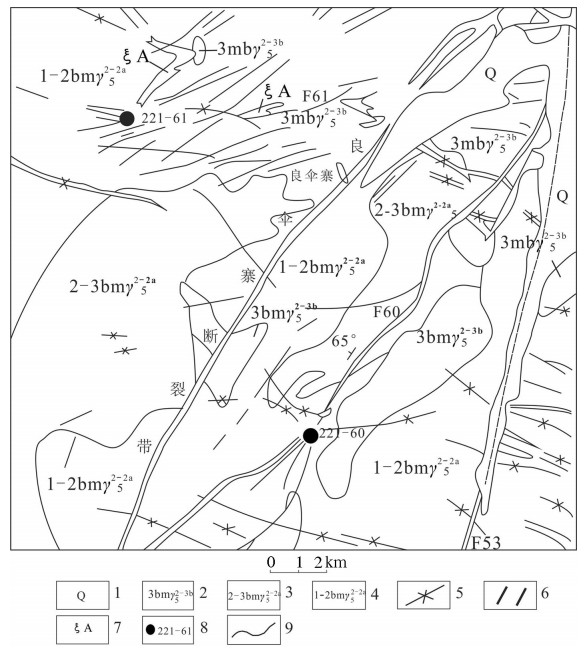
 下载:
下载:
